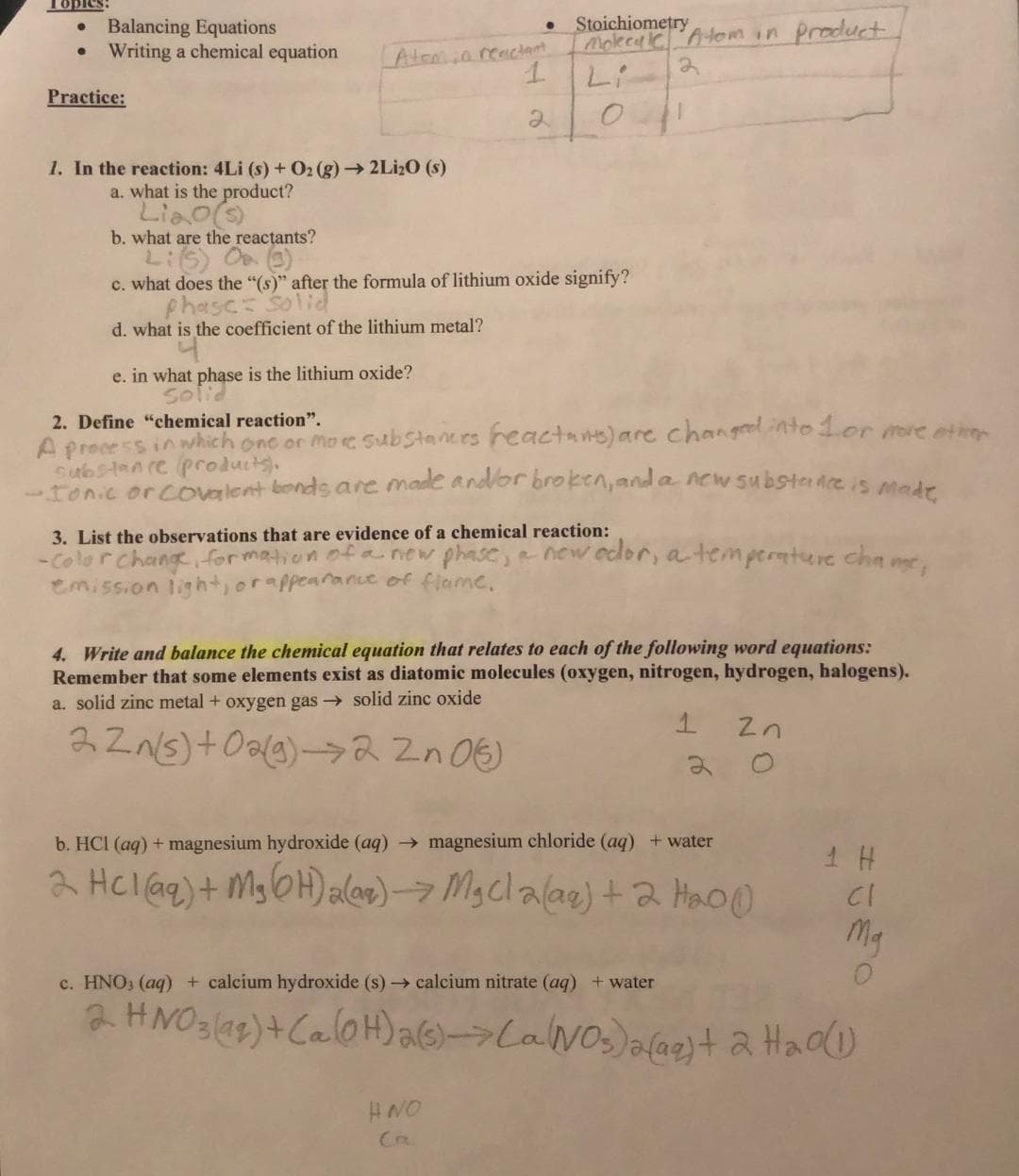4. Write and balance the chemical equation that relates to each of the following word equations: Remember that some elements exist as diatomic molecules (oxygen, nitrogen, hydrogen, halogens). a. solid zinc metal + oxygen gas → solid zinc oxide 1 22n(s) + O2(g) →→2 Zn 06) b. HCl (aq) + magnesium hydroxide (aq) → magnesium chloride (aq) + water 2 HCl(aq) + Mg(OH)2(ar) → Mgcla(aq) + 2 H₂O 20 HNO 1 H CI Mg c. HNO3(aq) + calcium hydroxide (s)→ calcium nitrate (aq) + water 2 HNO3 (12) + Ca(OH)2 (s)-> Ca(NO3)2(aq) + 2 H₂O(1)
4. Write and balance the chemical equation that relates to each of the following word equations: Remember that some elements exist as diatomic molecules (oxygen, nitrogen, hydrogen, halogens). a. solid zinc metal + oxygen gas → solid zinc oxide 1 22n(s) + O2(g) →→2 Zn 06) b. HCl (aq) + magnesium hydroxide (aq) → magnesium chloride (aq) + water 2 HCl(aq) + Mg(OH)2(ar) → Mgcla(aq) + 2 H₂O 20 HNO 1 H CI Mg c. HNO3(aq) + calcium hydroxide (s)→ calcium nitrate (aq) + water 2 HNO3 (12) + Ca(OH)2 (s)-> Ca(NO3)2(aq) + 2 H₂O(1)
Chemistry: Principles and Reactions
8th Edition
ISBN:9781305079373
Author:William L. Masterton, Cecile N. Hurley
Publisher:William L. Masterton, Cecile N. Hurley
Chapter21: Chemistry Of The Nonmetals
Section: Chapter Questions
Problem 73QAP: The amount of sodium hypochlorite in a bleach solution can be determined by using a given volume of...
Related questions
Question
100%
I need help with number 4. I need help with the balanced chemical equation for parts a, part b, and part c.

Transcribed Image Text:Topics:
●
Balancing Equations
Writing a chemical equation
Practice:
1. In the reaction: 4Li (s) + O2(g) → 2Li₂0 (s)
a. what is the product?
Liao (s)
b. what are the reactants?
Li(5) Oo (3)
Atom a reactant
1
●
e. in what phase is the lithium oxide?
Solia
c. what does the "(s)" after the formula of lithium oxide signify?
Phase: Solid
d. what is the coefficient of the lithium metal?
Stoichiometry
Molecule Atom in product
2
Li
2. Define "chemical reaction".
A process in which one or more substances reactants) are changed into 1 or more other
substance products).
-Ionic or covalent bonds are made and/or broken, and a new substance is made
3. List the observations that are evidence of a chemical reaction:
-Color Change, formation of a new phase, a new odor, a temperature chame,
emission light, or appearance of flame.
4. Write and balance the chemical equation that relates to each of the following word equations:
Remember that some elements exist as diatomic molecules (oxygen, nitrogen, hydrogen, halogens).
a. solid zinc metal + oxygen gas → solid zinc oxide
22n(s) + O2(g) →→2 Zn 06)
HNO
1
2
2n
b. HCl (aq) + magnesium hydroxide (aq) → magnesium chloride (aq) + water
2 HCl(aq) + Mg(OH)2(ar) → MgCl2(aq) + 2 H₂0)
1 H
CI
Mg
c. HNO3(aq) + calcium hydroxide (s) → calcium nitrate (aq) + water
2 HNO3 (12) + Ca(OH)2 (s)-> (a (NO₂)2(aq) + 2 H₂O(1)
Expert Solution
This question has been solved!
Explore an expertly crafted, step-by-step solution for a thorough understanding of key concepts.
This is a popular solution!
Trending now
This is a popular solution!
Step by step
Solved in 4 steps with 4 images

Knowledge Booster
Learn more about
Need a deep-dive on the concept behind this application? Look no further. Learn more about this topic, chemistry and related others by exploring similar questions and additional content below.Recommended textbooks for you

Chemistry: Principles and Reactions
Chemistry
ISBN:
9781305079373
Author:
William L. Masterton, Cecile N. Hurley
Publisher:
Cengage Learning

General Chemistry - Standalone book (MindTap Cour…
Chemistry
ISBN:
9781305580343
Author:
Steven D. Gammon, Ebbing, Darrell Ebbing, Steven D., Darrell; Gammon, Darrell Ebbing; Steven D. Gammon, Darrell D.; Gammon, Ebbing; Steven D. Gammon; Darrell
Publisher:
Cengage Learning

Chemistry & Chemical Reactivity
Chemistry
ISBN:
9781337399074
Author:
John C. Kotz, Paul M. Treichel, John Townsend, David Treichel
Publisher:
Cengage Learning

Chemistry: Principles and Reactions
Chemistry
ISBN:
9781305079373
Author:
William L. Masterton, Cecile N. Hurley
Publisher:
Cengage Learning

General Chemistry - Standalone book (MindTap Cour…
Chemistry
ISBN:
9781305580343
Author:
Steven D. Gammon, Ebbing, Darrell Ebbing, Steven D., Darrell; Gammon, Darrell Ebbing; Steven D. Gammon, Darrell D.; Gammon, Ebbing; Steven D. Gammon; Darrell
Publisher:
Cengage Learning

Chemistry & Chemical Reactivity
Chemistry
ISBN:
9781337399074
Author:
John C. Kotz, Paul M. Treichel, John Townsend, David Treichel
Publisher:
Cengage Learning

Chemistry & Chemical Reactivity
Chemistry
ISBN:
9781133949640
Author:
John C. Kotz, Paul M. Treichel, John Townsend, David Treichel
Publisher:
Cengage Learning

Chemistry: The Molecular Science
Chemistry
ISBN:
9781285199047
Author:
John W. Moore, Conrad L. Stanitski
Publisher:
Cengage Learning

Introductory Chemistry: A Foundation
Chemistry
ISBN:
9781337399425
Author:
Steven S. Zumdahl, Donald J. DeCoste
Publisher:
Cengage Learning